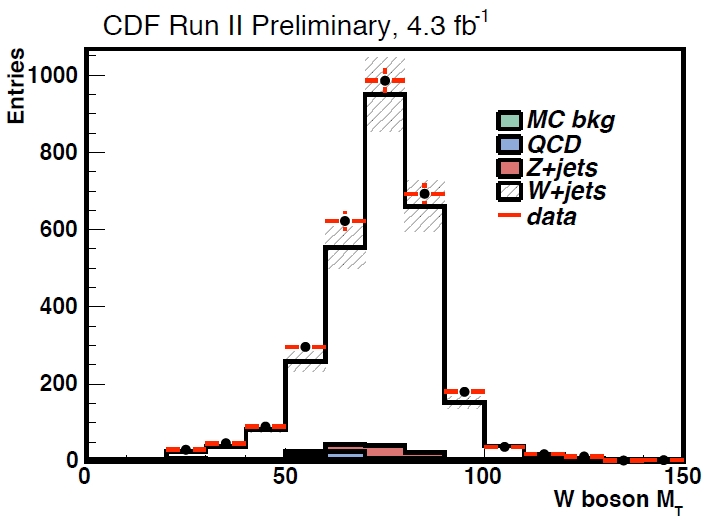 A question that has always caused headaches in experimentalists and theorists concerning W production is how large a fraction of these particles is produced in association with heavy-flavour quarks -charm and bottom ones. These heavier brothers of up, down and strange quarks are not contained in the colliding protons and antiprotons in significant amounts, and their observation together with a W boson in the final state of a collision is the result of a very distinct class of Feynman diagrams. For charm the typical process is the one shown on the right, where charm originates from a strange quark in the proton being transmuted by the weak interaction vertex which produces the W.
A question that has always caused headaches in experimentalists and theorists concerning W production is how large a fraction of these particles is produced in association with heavy-flavour quarks -charm and bottom ones. These heavier brothers of up, down and strange quarks are not contained in the colliding protons and antiprotons in significant amounts, and their observation together with a W boson in the final state of a collision is the result of a very distinct class of Feynman diagrams. For charm the typical process is the one shown on the right, where charm originates from a strange quark in the proton being transmuted by the weak interaction vertex which produces the W.The reason for the importance of a precise estimation of the W+charm cross section lies with the fact that this is one sizable background to many crucial searches: those of the top quark, and those of Higgs bosons, for instance. Such background has been usually estimated with Monte Carlo simulations in those analyses, and a large systematical uncertainty has always been associated to its rate; typically, 40%.
A recent analysis by a group of Harvard physicists in CDF has however shown that the W+charm production rate appears to be double of what Next-to-Leading Order calculations predict. In 4.3 inverse femtobarns of proton-antiproton collisions, the group selected events with a leptonic W boson decay to electron-neutrino or muon-neutrino pair; the charm quark is identified as a jet which also contains a semileptonic decay -a "soft" electron or muon contained within the jet cone. The signal consists in an excess of events where the "soft" lepton has charge opposite to that of the W lepton.
Below you can see the signal (empty histogram) and the backgrounds, in the spectrum of reconstructed "transverse mass" of the lepton-neutrino system originated by the W decay.

The cross section for W+charm production, multiplied by the leptonic W branching ratio, is measured to be 33.7+-11.4+-4.7 picobarns, while NLO theory predicts 16.5+-4.7 pb. The measurement is thus twice as large as the prediction, but the error bar does not yet allow to draw definite conclusions on the accuracy of the theoretical estimate. Given the importance of the trustworthyness of Monte Carlo predictions for heavy flavour production in association with vector bosons, particularly for ongoing Higgs searches, this number is one to watch. It would be very nice if DZERO produced a similar estimate in the near future.





Comments